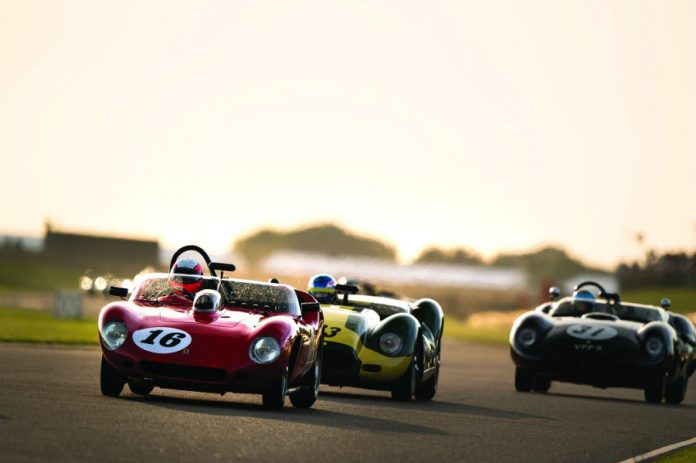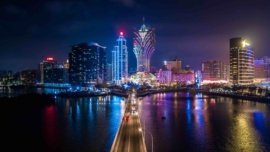Every year in September, a small town in the south of England returns to the glorious years of motorsport to celebrate the passion for cars
By Guilherme Marques


It was on September 18, 1948 that the first race took place at the Goodwood circuit in Chichester, West Sussex. Organised by the Junior Car Club, which would later change its name to the British Automobile Racing Club, the race was authorised by the Duke of Richmond and Gordon, owner of the property. This property is called Goodwood House, where, during the Second World War, the Royal Air Force built a small airfield, which proved instrumental in the Allied war effort. The circuit was nothing more, nothing less than the perimeter of that same aerodrome.
Goodwood became so famous that it became the scene of renowned events such as the Tourist Trophy, rivalling in prestige with Silverstone, the largest and most important English track. At one point, even Formula One organised a Grand Prix in the Duke’s gardens. The idea of recreating the racing atmosphere of the 1940s, ‘50s, and ‘60s gave rise to an event named the Goodwood Revival, a three-day festival every September. The first edition took place half a century after the circuit opened and 22 years after it received its last official race.
But where does the Goodwood Revival come from? The ‘fault’ lies with a gentleman named Charles Henry Gordon-Lennox, also known as the 11th Duke of Richmond, 11th Duke of Lennox, 11th Duke of Aubigny and 6th Duke of Gordon. Heir to the Goodwood Estate, this car lover is still president of the British Automobile Racing Club, Patron of the TT Riders Association and honorary member of the British Racing Drivers Club and the Guild of Motoring Writers.

The Duke of Richmond, as he is usually referred to since his father’s death in 2018 – prior to that, his title was Lord March –, wanted to bring car racing back to the Goodwood Circuit, but no official race could be organised there due to safety issues relating to the drivers and spectators. And so, Charles Gordon-Lennox came up with the brilliant idea of creating a festival entirely dedicated to cars where an unofficial race could be held.
So, in 1993, the Goodwood Festival of Speed (FoS) was born. Open only to guests of the Duke, the participants adhered to the idea on a massive scale. In the first year, the event received 25,000 visitors. The success of the FoS was so significant that two things happened as a direct consequence: the first was the creation of the Goodwood Revival five years later, to separate new cars from classic cars at different events; the second was the decline of car shows as they were known up until that point. The typical car shows, where tradition dictated that the brands presented their newest creations, could not adapt to the times, and the Festival of Speed and Revival showed that drastic changes were underway, in how people see, use and understand a car.
The Goodwood effect
For the past five years, some of the world’s biggest brands have been absent from the biggest stages, such as the Geneva, Frankfurt, Paris and Detroit Motor Shows, and have created new ways to communicate their products to potential customers. The fall of the car show is a testament to the fact that stationary vehicles on brightly lit platforms no longer have the appeal of old. People want to see cars in action and be able to interact not only with the automobiles, but with industry personalities such as drivers, engineers, designers and so on. All this happens at Goodwood.
The success of the FoS naturally led to the success of the Goodwood Revival, which quickly became the biggest classic car event on British soil. The number of visitors increases from year to year and the echoes of the event have a farther and stronger reach than ever before.
The re-enactment of the old-fashioned races is like a trip to the past, where not only the cars but also the people must comply with the tradition of that period. Most of the attendees dress up, embodying characters from the 1950s and 60s, and modern cars are not even allowed in the perimeter of Goodwood House, except those related to safety, such as police and fire brigade.
The races themselves are a reflection of times gone by, not only in terms of cars and drivers, but also in the ferocity of the competition. It isn’t unusual to see cars worth several tens of thousands of euros scraping past one another in pursuit of the best place in the standings. The public, of course, goes wild, and the owners of such machines seem more concerned with making this a weekend to remember than preserving the paint of their bolides. Anything damaged can always be repaired the following week.


Goodwood Revival 2019
Summer stayed true to its name until the end and the south of England was blessed with three hot days, perfect for the Revival 2019. For those who thought the event might not live up to expectations, the first race of the weekend, called the Kinrara Trophy for the pre-1963 closed cockpit cars with an engine capacity of over 3000cc, was won by Gary Pearson and Andrew Smith behind the wheel of a Ferrari 250 GTO – one of 36 produced and widely recognised as the most valuable car in the world, with valuations reaching $70 million. In second place was an Aston Martin DB4GT and in third a Ferrari 250 GT SWB C. This meant that, to kick off the festivities, the first podium represented around $100 million. By the way, in fourth place, in another Ferrari 250 GT SWB, was Tom Kristensen, the absolute record holder of Le Mans 24 Hours wins, with nine titles under his belt. Welcome to the Goodwood Revival.
Every year there is a special celebration of an important anniversary in the history of cars, and this year the choice fell on the 60th anniversary of the Mini. Sir Alec Issigonis’s iconic design is an industrial symbol of the United Kingdom and the Revival was the place to celebrate the 60 years of the model that gave it its name. It brought together 150 participants with Mini models, including four very special cars once owned by a group of friends from Liverpool named John, Paul, George and Ringo, who became famous for forming a music band that was quite successful in the ‘60s.

Outfits from these and other eras are gaining followers – the number of visitors joining in with vintage costumes is increasing year by year – and it creates an absolutely unique atmosphere that gives Revival an aura unlike any other classic car festival. It is as if the event were only for true lovers, for those who are willing to do whatever it takes to enjoy the cars. Alongside the action on the track, it is common to run into big names in the world of motorsports in the gardens of Goodwood House, and 2019 was no exception. Dario Franchitti, Jeff Gordon, Derek Bell and Jochen Mass mingled with the crowd and showed that love of automobiles is an excuse for a little chat even with strangers.
Throughout the 15 races of the weekend where competition is always present and the desire to win is as great as the cost of the cars, spectators were presented with an unforgettable event that has the power to always end on a positive note: next year there is more.































